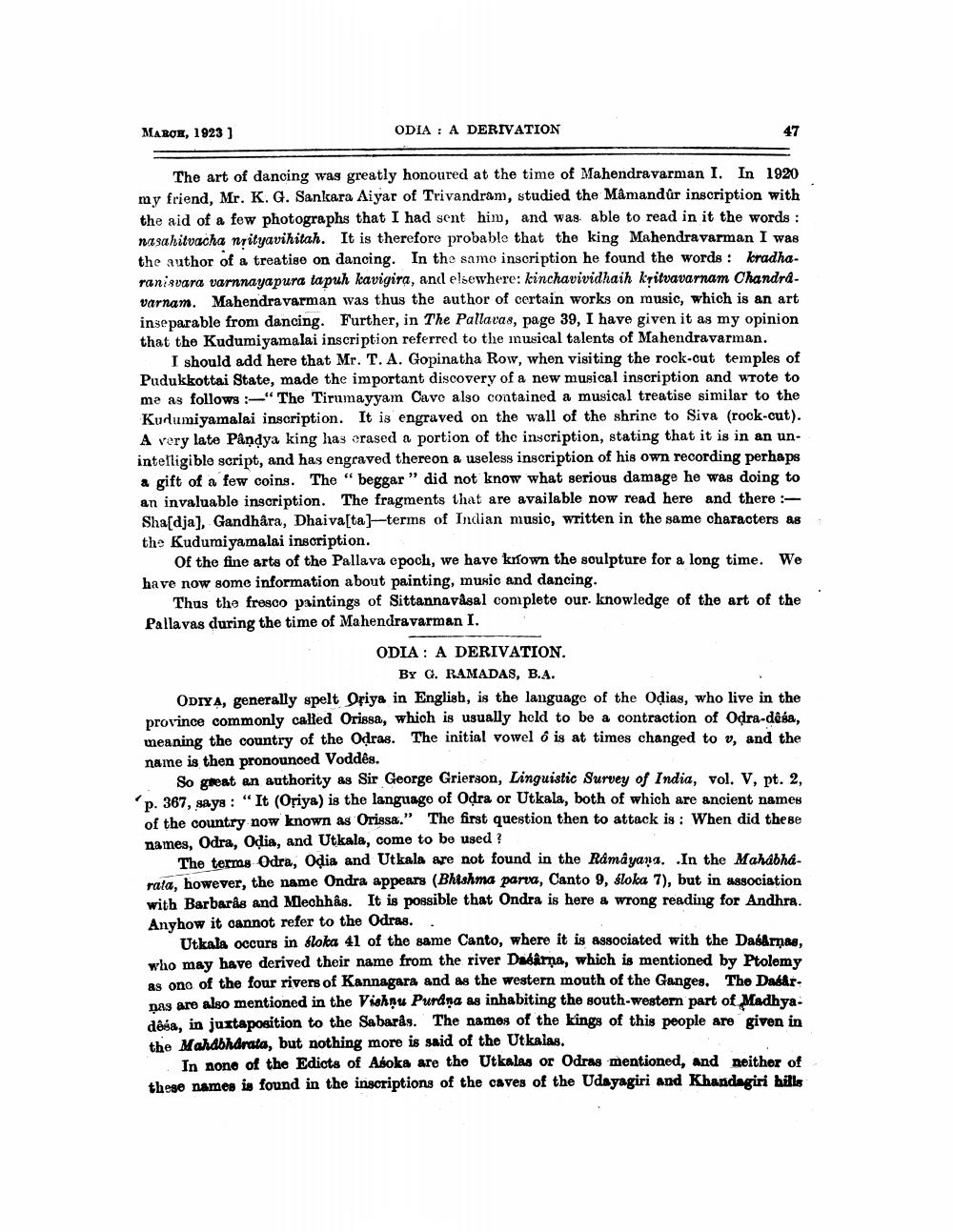________________
MAROE, 1923)
ODIA : A DERIVATION
47
The art of dancing was greatly honoured at the time of Mahendravarman I. In 1920 my friend, Mr. K. G. Sankara Aiyar of Trivandram, studied the Mâmandûr inscription with the aid of a few photographs that I had sent him, and was able to read in it the words : nasahitvacha nrityavihitah. It is therefore probable that the king Mahendravarman I was the author of a treatiso on dancing. In the samo inscription he found the words : kradharani svara varnnayapura tapuh kavigira, and elsewhere: kinchavividhaih kritvavarnam Chandrdvarnam. Mahendravarman was thus the author of certain works on music, which is an art inseparable from dancing. Further, in The Pallaras, page 39, I have given it as my opinion that the Kudumiyamalai inscription referred to the musical talents of Mahendravarman.
I should add here that Mr. T. A. Gopinatha Row, when visiting the rock-cut temples of Pudukkottai State, made the important discovery of a new musical inscription and wrote to me as follows :-"The Tirumayyam Cave also contained a musical treatise similar to the Kurumiyamalai inscription. It is engraved on the wall of the shrine to Siva (rock-cut). A very late Pandya king has erased a portion of the inscription, stating that it is in an unintelligible script, and has engraved thereon a useless inscription of his own recording perhaps a gift of a few coins. The "beggar" did not know what serious damage he was doing to an invaluable inscription. The fragments that are available now read here and there :Sha[dja), Gandhåra, Dhaiva[ta]-terms of Indian music, written in the same characters as the Kudumiyamalai inscription.
Of the fine arts of the Pallava epoch, we have kilown the soulpture for a long time. We have now some information about painting, music and dancing.
Thus the fresco paintings of Sittannavåsal complete our knowledge of the art of the Pallavas during the time of Mahendravarman I.
ODIA : A DERIVATION.
BY G. RAMADAS, B.A. ODIYA, generally spelt Oriya in English, is the language of the Odias, who live in the province commonly called Orissa, which is usually held to be a contraction of Odra-desa, meaning the country of the Odras. The initial vowel 6 is at times changed to v, and the name is then pronounoed Voddês.
So great an authority as Sir George Grierson, Linguistic Survey of India, vol. V, pt. 2, 'p. 367, says: “It (Oriya) is the language of Odra or Utkala, both of which are ancient names of the country now known as Orissa." The first question then to attack is: When did these names, Odra, Odia, and Utkala, come to be used ?
The terms Odra, Odia and Utkala are not found in the Ramayana. In the Mahabharata, however, the name Ondra appears (Bhishma parva, Canto 9, sloka 7), but in association with Barbaras and Mechhâs. It is possible that Ondra is here & wrong reading for Andhra. Anyhow it cannot refer to the Odras...
Utkala occurs in floka 41 of the same Canto, where it is associated with the Dabarnas, who may have derived their name from the river Dasárna, which is mentioned by Ptolemy as ono of the four rivers of Kannagara and as the western mouth of the Ganges. The Dasar. nas are also mentioned in the Vishnu Punana as inhabiting the south-western part of Madhyadêsa, in juxtaposition to the Sabarás. The names of the kings of this people are given in the Mahabhdrata, but nothing more is said of the Utkalas.
In none of the Edicts of Asoka are the Utkalas or Odras mentioned, and neither of these names is found in the inscriptions of the caves of the Udayagiri and Khandaqiri hills




